Should pocket cartoons ever be considered in the same category as political ones?
Should pocket cartoons ever be considered in the same category as political ones? I raise this question mainly because a number of pocket cartoonists believe they have been unjustly pigeonholed by people like myself who treat their work as substantially different from that of political cartoonists. They have complained that, although their work regularly appears in the same newspapers that feature political cartoons, they do not receive the same attention as their larger-scale counterparts. Indeed, large-scale, finely drawn political cartoons have long been celebrated and many have become iconic, from James Gillray’s ‘The Plumb-pudding in Danger’, to John Tenniel’s ‘Dropping the Pilot’, to David Low’s ‘Rendezvous’. Pocket cartoons – small-format, economically drawn, topical gags – are certainly popular, but, as James Whitworth, a pocket cartoonist whose work features in the Sheffield Telegraph, Private Eye and others, wistfully points out, they have, overall, received less attention from cartoon enthusiasts. It has even led to some pocket cartoonists complaining about their exclusion from the Britian's Best Political Cartoons anthology over the last few years. So, are there fundamental differences in the form and function of pocket and political cartoons? And is my exclusive focus on political cartoons justified?
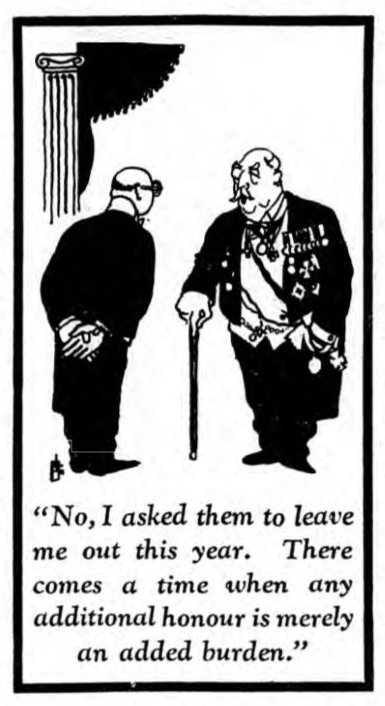 Osbert Lancaster's first ever pocket cartoon.
Osbert Lancaster's first ever pocket cartoon.
Of course, one must bear in mind that political cartoons have the advantage of having been around for over 300 years. The first pocket did not appear in the British press until just 82 years ago – 3 January 1939, to be precise – and it came about purely by chance. The poet John Betjeman had been commissioned to write a series on archaeology for the Daily Express and had asked Osbert Lancaster, at that time an architectural historian and illustrator for the Architectural Review, to assist him. One night over dinner, Lancaster happened to mention to the Express’s features editor, John Rayner, how much he admired the little column-width cartoons that regularly appeared in the French newspapers and wondered why they had never caught on in the British press. To Lancaster’s rather pleasant surprise (given that the Daily Express had at that time the largest circulation in the world for a national newspaper), Rayner replied, ‘Go ahead, give us some.’ Lancaster did so and Rayner duly labelled them ‘pocket cartoons’ in reference to the German ‘pocket battleships’ that were then constantly in the news. Lancaster’s first cartoons were positioned in Tom Driberg’s ‘William Hickey’ gossip column. Driberg, who had known Lancaster from his days up at Oxford, was more than happy with them. ‘They had the additional merit,’ Driberg joked, ‘of relieving me of about three inches of writing space.’ Lancaster’s cartoons were immediately distinctive. Whereas contemporary political cartoonists such as David Low were busy skewering the likes of Hitler and Mussolini, Lancaster’s cartoons were more generally observational, finding the humour in everyday life. He particularly enjoyed poking gentle fun at the English upper classes, their fashions, political views, and responses to social change. Over time, he developed a cast of characters, not least Maudie, Countess of Littlehampton, whom he used to satirise the establishment to which he belonged. Such was the popularity of Lancaster’s cartoons that, when war did break out, they were transferred to the front page. This was something of an enigma to the newspaper’s proprietor, Lord Beaverbrook, who once asked his aide, George Malcolm Thomas, ‘What is the point of Osbert Lancaster?’ (The hostility was mutual: ‘He was a bastard,’ Lancaster said of the proprietor.) In spite of Lord Beaverbrook’s puzzlement, Lancaster’s cartoons remained on the front page. In fact, as Lancaster later recalled, the war gave him an unexpected advantage: ‘Then there was a stroke of luck, the war started and there was paper rationing. All the other cartoonists were given less space, and I remained the same size. It made me look much more important.’ As wartime restrictions drove 24-page broad- sheets down to four large pages and 36-page tabloids down to eight small pages, the benefits of pocket cartoons became apparent to other news- papers, too. Within a matter of months, Roland ‘Neb’ Niebour’s pocket cartoons began appearing in the Daily Mail and Frederick Joss’s in the Star. ‘It is easy to understand the editorial popularity of the pocket cartoonist, in these days of paper shortages,’ a 1942 piece in the London Opinion said. ‘The artist who can get his joke across in a couple of square inches of newsprint is a man after the editor’s own heart.’ Even Hitler seems to have been a fan. When the ruins of his chancellery in Berlin were pored over in May 1945, a cutting of one of Neb’s pocket cartoons, from the Daily Mail of 15 January 1945, was found among the ruins.
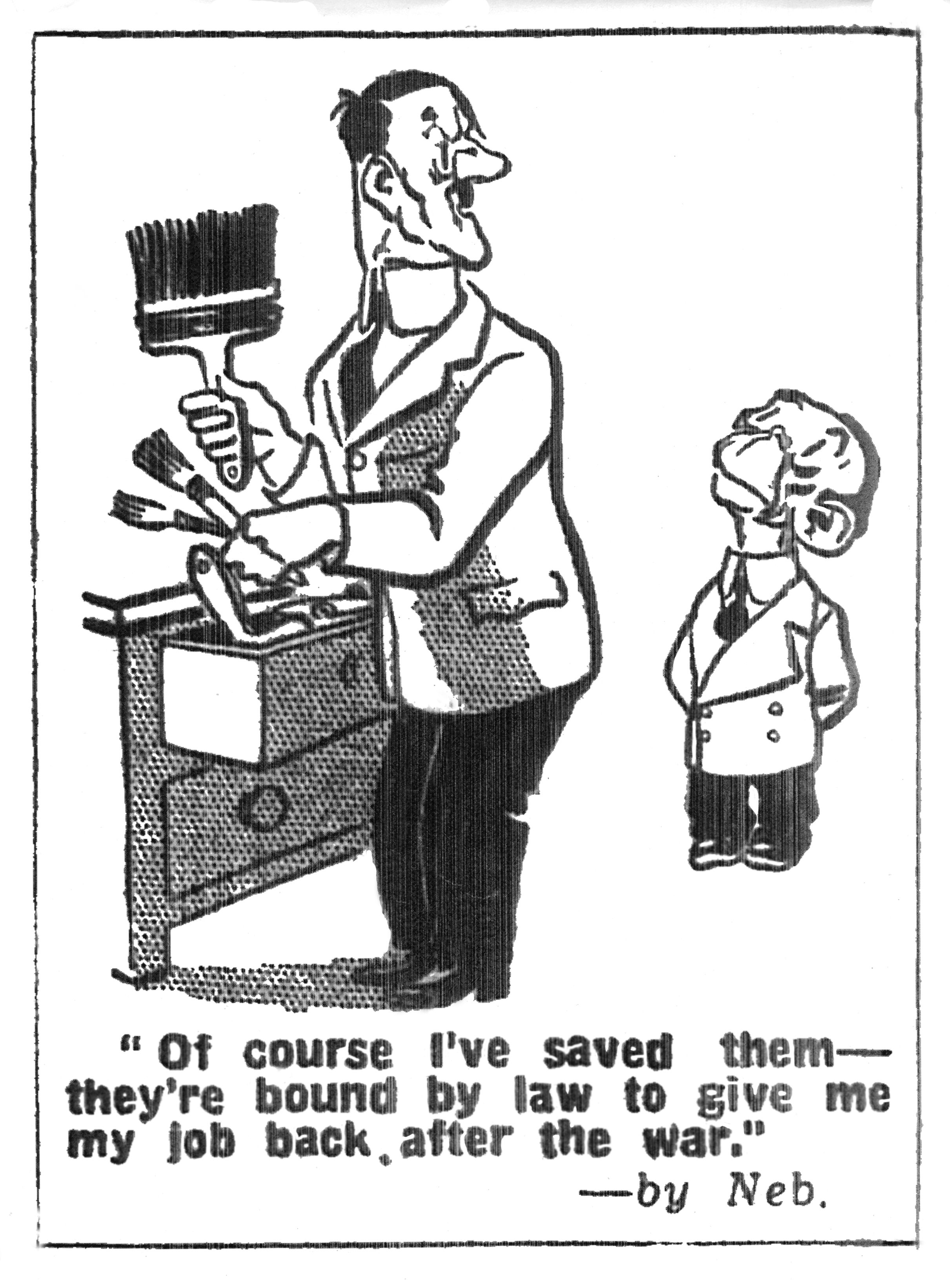 This Neb cartoon was found in the Fuhrerbunker after the war.
This Neb cartoon was found in the Fuhrerbunker after the war.
The post-war years saw the arrival of the first female pocket cartoonists, among them Margaret Belsky. Belsky, who began working for the Daily Herald in 1951, regarded herself modestly as ‘just a hack’ and ‘the poor man’s Osbert Lancaster’, although she drew over 6,000 cartoons for the paper and was the first woman to draw a front-page cartoon for a national publication. Antonia Yeoman, who worked for Punch in the 1950s, was also widely admired and similarly understated about her talents. She once told an interviewer, ‘I wake up in the morning in terror wondering if I’ll be able to think of any more jokes . . . I’m not really interested in politics or news, so that makes it difficult.’ However, the prejudice against female cartoonists at the time meant that both felt obliged to hide their gender. Margaret Belsky used only her surname, while Antonia Yeoman signed her cartoons ‘Anton’.
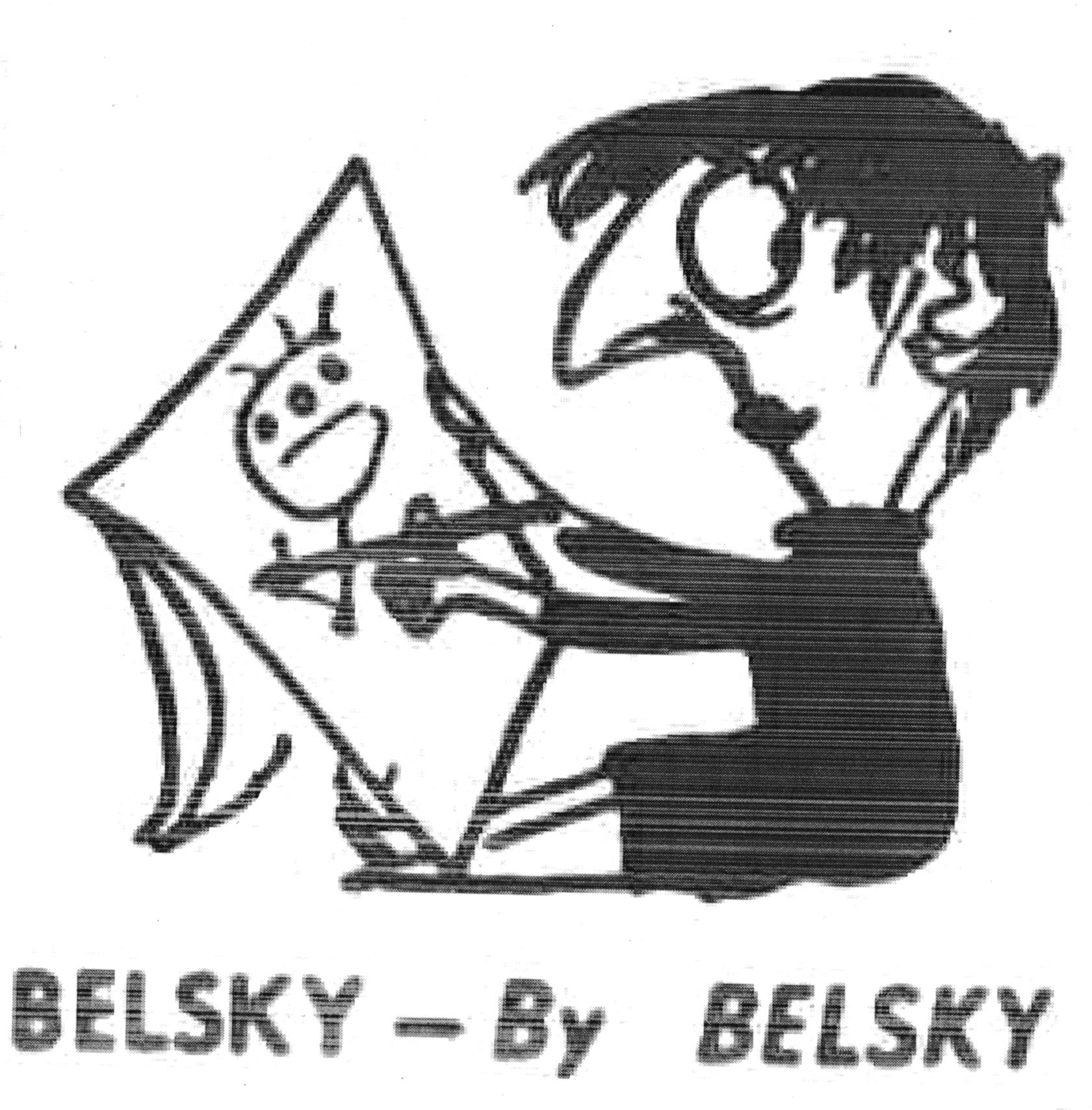 Belsky by Belsky
Belsky by Belsky
By the time Osbert Lancaster retired in 1981, he had produced in excess of 10,000 cartoons. Drawn on any old scrap of paper that came to hand, rarely signed, and crudely and speedily drawn, his later cartoons do not represent his finest work as an artist. But Lancaster’s popularity was such that his work had spawned a new breed of pocket cartoonists in both broadsheet and tabloid newspapers. Several of the most prominent took Lancaster’s minimalism a step further. Rudimentary figures with simple bulbous noses were the hallmark of Mel Calman and Bryan McAllister’s work in the 1970s. David Austin in the Guardian, Mark Boxer (who used the pen-name ‘Marc’) in the Observer, Tony Holland at the Daily Telegraph and Barry Fantoni in The Times followed a similarly stylised, if individually distinctive, approach in the 1980s and 1990s.
Today, a new generation of prominent pocket cartoonists is at work including Nick Newman, Jeremy Banks (known as ‘Banx’), Tim Sanders and Jonathan Pugh. The best-known practitioner of them all, though, is Matthew Pritchett. Better known as Matt, Pritchett started working for the Daily Telegraph in 1988 and since then has produced a front-page cartoon for the paper every day. In the process, not only has he become the highest-paid cartoonist in Britain, but he has also achieved the kind of status that most political cartoonists can only dream of: he has received multiple Cartoonist of the Year titles at the Press Awards for his work, as well as an MBE. It is hardly surprising that in the eyes of Telegraph readers, Matt overshadows his cartooning colleagues. Many leading politicians over the last few years have claimed Matt to be their favourite political cartoonist, even though Matt has specifically stated that he does not consider himself to be one. Former prime minister John Major admired his ‘gentle, under- stated humour’. Gordon Brown has said that ‘If a picture can paint a thousand words, then a pocket cartoon conjured up by Matt can regularly do even more.’ Theresa May thinks Matt is ‘great’ at taking major political events and seeing the humour in them: ‘It’s always good for politicians to laugh at ourselves and he helps us to do that.’ Admittedly, not all political leaders have been such great fans. Former Labour leader Jeremy Corbyn was of the belief that none of the cartoons Matt had drawn about him were in the least bit funny, perhaps because they often portrayed him as bumbling and inept. But Corbyn is something of a lone voice. Matt’s fan base even extends to royalty. Prince Philip, the late Duke of Edinburgh, called Matt a ‘genius’ for his ‘ability to think of wonderfully appropriate swipes at the idiocies of contemporary life’. Even if they have often been overshadowed by the great political cartoonists of the time, today’s pocket cartoonists are consumed and adored by massive audiences including some of the most influential people in the country. However, a few pocket cartoonists worry that the very size and nature of a pocket cartoon means they are not fully appreciated by cartoon aficionados. Nick Newman, pocket cartoonist for the Sunday Times, argues that ‘Pocket cartoons are treated less seriously, partly due to size, partly due to position [political cartoons are mostly located opposite the editorial] and partly due to portentousness of message.’ Newman’s position indicates a Napoleon-like concern that the diminutive size of pockets make them seem less noteworthy. However, many cartoonists have pointed out that there are significant benefits to drawing small-scale cartoons. Kathryn Lamb, pocket cartoonist for Private Eye and the Spectator, stoutly believes it is ‘an advantage to do smaller drawings’. Indeed, there can be no doubt that the size of the pocket cartoon gives it a certain upper hand over its political relative. Pocket cartoons naturally take much less time to draw, so the cartoonist can devote more time to coming up with ideas (or, as the Independent’s pocket cartoonist Tim Sanders jokingly sees it, time to ‘get to the pub quicker’). Russel Herneman, cartoonist for Private Eye, among other publications, suggests that the pocket cartoonist gains from the hours freed up for ‘the creative thinking process which can range from seconds to eons, within both genres’. Kipper Williams, who creates pocket cartoons for several publications including the Spectator, Private Eye and the Critic, says he prefers creating pocket cartoons to political ones as ‘it’s possible to cover a broader spread of topics and the relative speed of execution means you potentially get more bites of the cherry.’ Osbert Lancaster once admitted that ‘the cartoons only used to take about five minutes . . . no, maybe we’d better say fifteen – don’t want to make it sound too easy!’ This would have been an exasperating admission for the political cartoonist Sidney Strube, Lancaster’s contemporary at the Daily Express, who spent on average five to eight hours a day producing a cartoon. This is how he recalled Lancaster’s working practices to Punch cartoonist David Langdon:
“So I arrive each morning, sit meself [sic] down and start scratching my head for an idea . . . Then at about 11 o’clock, like clockwork, in comes the young feller [sic] Lancaster . . . After a few minutes he takes out a fountain pen of all things, scribbles a cartoon, gets up and walks to the editor’s cubicle at the far end of the newsroom. There’s a pause, followed by a loud guffaw. Lancaster emerges, tosses his piece of paper into an out-tray . . . And I sit at my drawing board sometimes to five o’clock in the ruddy evening.”
Strube’s frustration is understandable but arguably misplaced. Lancaster would most likely have spent hours beforehand thinking through his idea. In his younger days, he later confided, he would have done about eight roughs, seven of which would be rejected ‘out of hand’. It’s much the same for today’s pocket cartoonists. They may not devote hours to producing the final item, but the preliminary stage may well have taken a considerable amount of time. Jonathan Pugh, who delivers seven or eight drafts for his editor at the Daily Mail every day, describes the process as follows: ‘I’ll do rough drawings, which will be barely legible, with a caption underneath, which will give the editor an idea of what the cartoon might look like . . . The time-consuming bit is generally getting the caption right. The drawing I can get done in about half an hour.’ Matt similarly takes up to a day to hit upon the right concept for his cartoon. He will arrive at the Telegraph around eight in the morning to look through all the papers to see what the main news stories are. Then he adopts what he calls ‘a scattergun approach’, noting down dozens of possible cartoon ideas before refining them into six or seven roughs. At four o’clock, he shows the results to his editor. As Matt admits, ‘It’s very rare that the first one gets through, and very often it’s the very last one. I think of it as being a bit like colonic irrigation!’
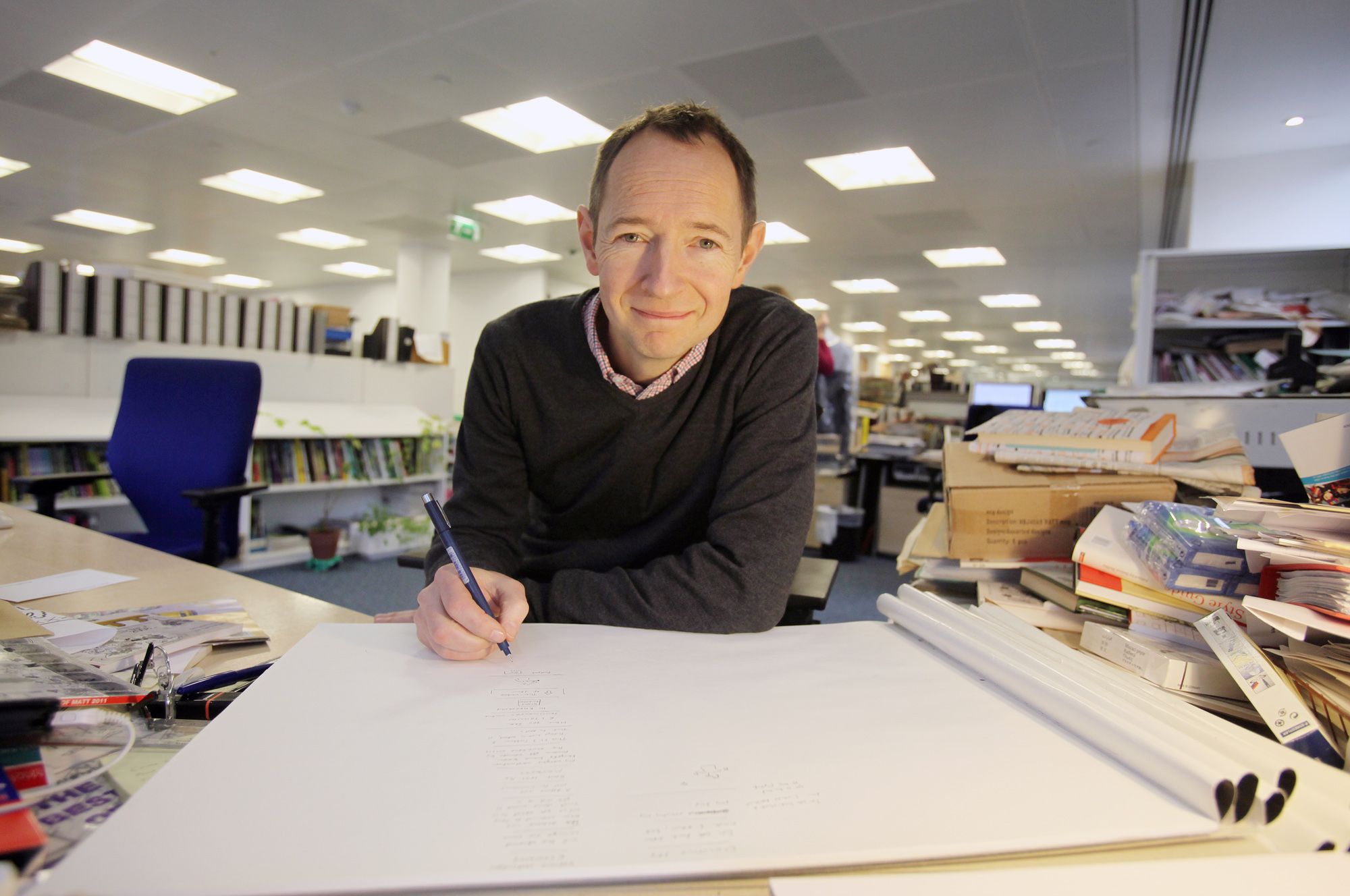 Cartoonist Matt at work
Cartoonist Matt at work
If the mental effort that goes into a pocket cartoon is considerable, the speed at which it is then executed means that it involves less detail and technique than is the case for political cartoons. In any case, by their own admission, pocket cartoonists tend to be less artistically gifted than political or even strip cartoonists. Their fundamental skill, after all, lies in being funny day after day. Matt has admitted that he is ‘not good at caricature and feet are impossible to draw’. He has acknowledged that he is heavily influenced by the drawing style of Bryan McAllister, a pocket cartoonist for the Guardian, who, according to political cartoonist Steve Bell, ‘couldn’t draw for toffees’. At his best, Osbert Lancaster was certainly a fine artist, but no pocket cartoonist since can really hold a candle to the great political cartoonists when it comes to artistic skill and execution. Among today’s crop of pocket cartoonists it’s hard to find any who match the impressive draughtsmanship of a Morten Morland, or a Peter Brookes, or a Dave Brown, or a Steve Bell. Mel Calman – one of the most successful and renowned practitioners of pocket cartooning – was, early on in his career, rejected by publication after publication because his draughtsmanship was deemed so poor. ‘I rather doubt if “cartooning” (as it is generally called) is really your line,’ the then art editor of Punch, Russell Brockbank, wrote in a rejection letter to Calman in 1956. ‘Neither drawings nor ideas measure up to the standard required here I’m afraid.’ Calman’s lack of drawing ability ironically led directly to his future success as a pocket cartoonist. He developed a minimal style that Steve Bell has referred to as ‘crude but exquisite’.
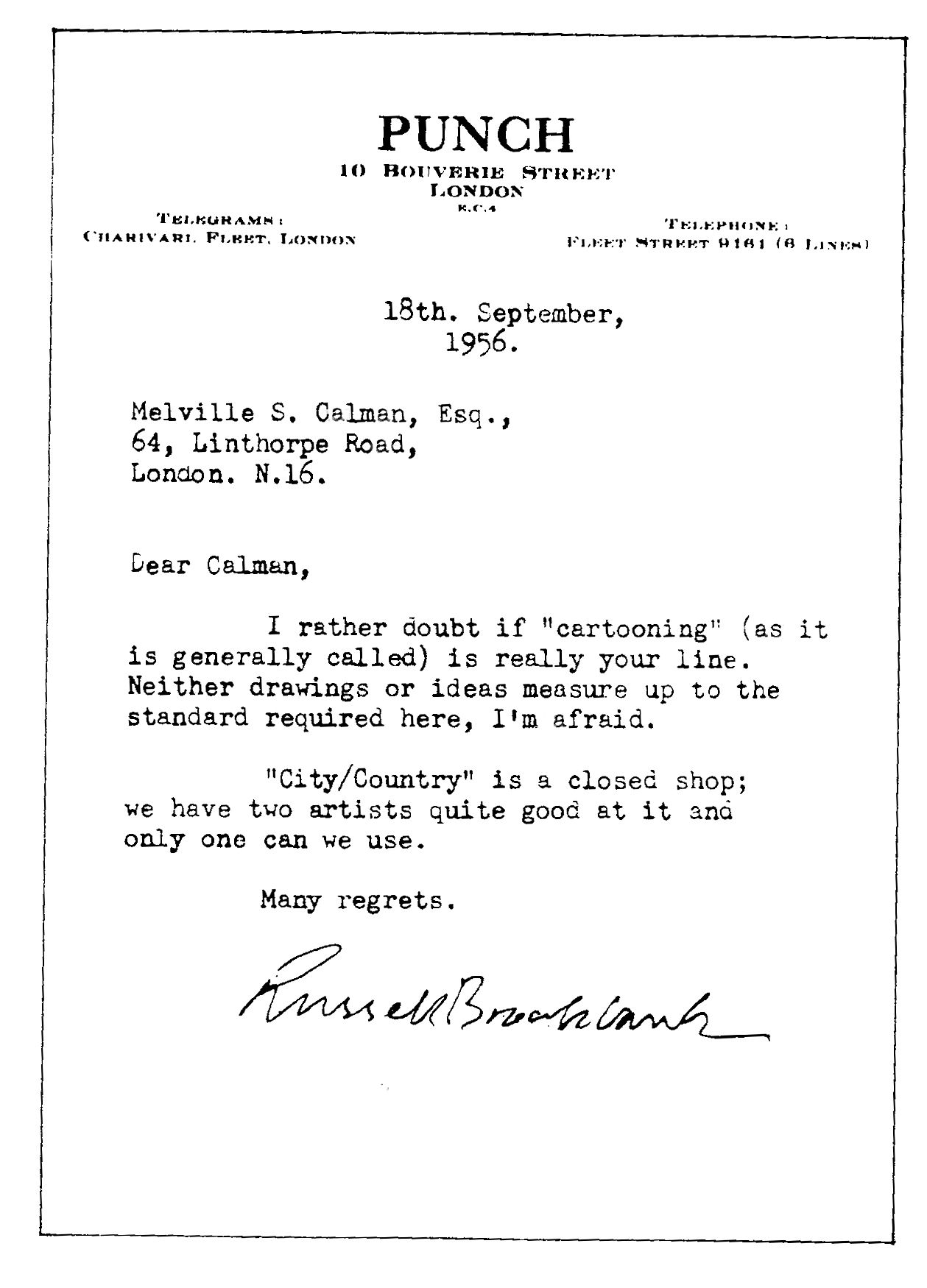 Mel Calman received this rejection letter from Punch editor Russell Brockbank
Mel Calman received this rejection letter from Punch editor Russell Brockbank
It appears that because of their limitations, pocket cartoonists feel more at home with the smaller format of pockets. Kathryn Lamb confides that she lacks the confidence to draw on a larger scale. ‘I was naturally inclined to do smaller drawings,’ she told me. Jonathan Pugh has also admitted that ‘anything much bigger and I’m drowning at sea’. In 1987, Nick Newman struggled when he stepped up to the larger-format cartoon to fill in temporarily for Wally Fawkes as the political cartoonist for the London Daily News. According to Newman, ‘My very rare forays into serious “political” cartooning weren’t very successful as I think I don’t have the skill to make up for the lack of a joke with sublime artistry – which some “political” cartoonists use to great effect.’
To say that pocket cartoonists lack the ‘sublime artistry’ to fill a larger format is not in itself a criticism. Pocket cartoons are, after all, a form of shorthand. Their exponents must be able to convey an idea in a succinct, minimal way to fit the smaller space. One must also remember that it is the caption that is all-important to the pocket cartoon, so there is no requirement for it to be a masterpiece. In fact, Mel Calman believed that 90 per cent of his work lay in the caption. The opposite is true of political cartooning, which requires detailed and skilled drawing to get the idea across.
The focus on basic idea and caption highlights the essential way in which the purpose of pocket cartoons differs from that of political ones: they are there, quite simply, to amuse the reader. Nick Newman says, ‘Political cartoonists can get away with a beautiful drawing and a chin-stroking “joke” but the pocket cartoonist just has to be funny.’ Jeremy Banks, pocket cartoonist for the Financial Times, the Spectator and many other publications, confirms the point: ‘A pocket cartoon without the gag is nothing,’ he argues. If there is a political agenda to a pocket cartoon, then it is very much a secondary consideration. Matt, for example, is clear that he is not interested in doing ‘statement’ cartoons, preferring to stick to jokes. Although the subject of his cartoons usually follows the main news story, as long as they are funny and vaguely topical then he finds his editor is happy. ‘People tell me that my cartoons occasionally make political statements,’ he says, ‘but all I am going for is the cheap laugh.’ If his cartoons do occasionally make a political point, then it’s ‘usually by mistake’. When pocket cartoons are political, they tend to be less interested in particular politicians than in how daily events affect ordinary people. According to Pugh, ‘My cartoons have always been about everyday life. I was once asked to produce a daily cartoon on Iraq, but death and bombs aren’t funny, so I focused on life’s irritations – all that sand, machines not working and equipment shortages.’ Matt describes his work in a similar vein as focusing on ‘ordinary people affected by life’.
Political cartoons, by contrast, are strictly a medium for political comment. They focus on key events and the actions of the political elite, and their objective is to hold politicians to account through both humour and ridicule. Often this is achieved by either visual metaphor or by conflating two news stories. Pugh uses a cricket analogy to differentiate between political and pocket cartoons: It’s a bit like batting and bowling – same game, but a very different agenda. I like to think the purpose of the newspaper pocket cartoon is to cheer people up; a little oasis and light relief amid the daily gloom. The political cartoon is more about meaty hits into the solar plexus – sure, the odd light jab for a laugh – but it’s there to express an opinion and get a point across, not simply to amuse. Political cartoons are often very funny, but they do not have to be. In fact, humour can sometimes be inappropriate in a political cartoon if the subject matter is sober or tragic. Many political cartoons over the years have been serious. A prime example is a cartoon by Victor ‘Vicky’ Weisz published in the News Chronicle of 26 September 1950 following the coal mining disaster at Creswell Colliery. Entitled ‘The Price of Coal’, the cartoon depicts the families affected by an underground fire that killed 80 miners and makes a deeply serious point about workers’ rights and the dangers of the mining industry. So, is categorising cartoons useful or is it a complete irrelevance to most observers? Nick Newman, for one, thinks categorisation is largely meaningless. ‘Categorisation helps aficionados and academics to pigeonhole cartoonists,’ he says, ‘but I think, for readers, cartoons are all one and the same . . . cartooning is just cartooning.’ Russel Herneman similarly argues that the only quality anyone cares about in any cartoon format is whether the cartoon is funny or not, and that any attempt to distinguish between genres ‘owes more to semantics than politics’. I disagree. I am fascinated by the variety within the cartoon medium and I believe it is valuable to make distinctions between the different strands. There are, of course, pocket and political cartoons. There are social cartoons which lie somewhere in the middle; they intend to make the reader laugh but are drawn on a larger scale (Stan ‘Mac’ McMurtry and Paul Thomas come to mind). Then there are strip cartoons, which Kipper Williams thinks straddle all cartoon formats as they ‘allow extra detail that wouldn’t be so viable in a pocket cartoon’ and which Steve Bell enjoys as ‘you can do things at length and in more depth and you can be sillier and ruder.’ Bell himself has drawn both political and strip cartoons for the Guardian. Paul Thomas has drawn political, social and pocket cartoons during his career. All of these cartoon forms can be equally enjoyed, but they are nevertheless clearly recognisable by their size and technique and can be distinguished by whether they set out to entertain or provoke. When it comes to editing books of cartoons, I believe it is indeed both necessary and more meaningful to categorise.
As to whether political cartoons are ‘better’ or more worthy of being singled out, opinions vary sharply. Some believe that pocket cartoons have a greater impact on readers because they deliver a joke rather than a political sermon. According to Thomas, ‘Pockets are rarely as pompous as political ones where the cartoonist seeks to display his social conscience as a replacement for a clever or funny idea.’ Andy Davey, cartoonist for the Independent, Telegraph and Evening Standard, among others, believes ‘A clever pocket cartoon can often do a better job at telling a political story than the overworked, self-righteous editorial cartoon.’ Osbert Lancaster stated that his aim was not to preach or put over a particular political point of view, which he saw as a problem for the overtly political cartoonist. Political commentator Andrew Marr is of the opinion that Matt’s influence has been greater than that of his political colleagues as he ‘has dug himself into the consciousness of millions as few of his angrier, more flamboyant rivals have done’.
Champions of political cartoons, by contrast, point to those iconic works by Gillray, Low and Vicky, which have, over time, achieved a permanence in our collective memory. Political cartoons offer us an artistic visual commentary that vividly documents our political and social world in incredibly creative and witty ways. The smaller-format, quick-fix pocket cartoons are brilliantly funny but they can only offer a snapshot of the contemporary scene and, unlike political cartoons, pockets can lose their meaning as humour changes through the years. By contrast, the political cartoonist’s perspective on the body politic can become a valuable historical resource to tap into in order to recall the varying perspectives and nuances of that time. That is why I have always championed them. We are fortunate enough to be living at a time when both pocket and political cartoons are thriving – to the daily delight of millions of newspaper readers up and down the country. But I hope that as you browse through this latest collection of political cartoons you recognise them for the valuable, artistic and thought-provoking records of an extraordinary 12 months in British history that I believe them to be.
 View Account
View Account